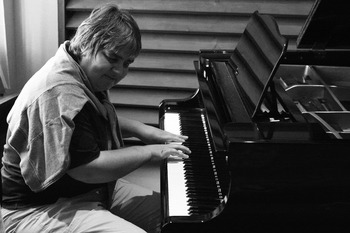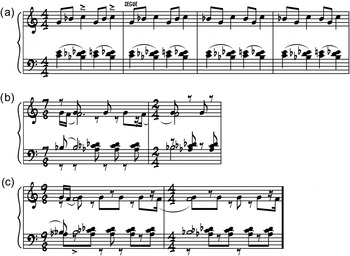‘Dico patata ancora caduto rotto’ (‘I say potato again fallen broken’): this is the unique, apparently meaningless sentence pronounced by Simona Concaro during her life. She was 5 years old at that time, having been diagnosed as severely autistic 2 years earlier. Simona's parents remained completely amazed by those sounds, still unaware that the exceptional event would not have occurred a second time.
Simona, in fact, had never tried a word, just whistled or mumbled. However, she had a very peculiar interest: music. Her father, an amateur musician, often played jazz in their living room with some friends. When Simona was 4 years old, a piano was brought to her home. Her parents attempted to teach her some music rudiments, but she always refused to play according to the ‘common’ way. Through the years, she has continued playing her own way, standing and rocking on her legs in front of the keyboard, repeating her monotonous melodies. Simona's potential talent was not immediately noticed by her family: the repetitive sound and movement were considered as an umpteenth stereotypy. Nonetheless, her interest for music did not vanish but was cultivated in secret (Politi et al. Reference Politi, Fusar-Poli, Ancona, Pozzato, Rocchetti, Garda and Keller2015).
Several years later, after a long period spent in a Swiss residential facility, Simona moved to Cascina Rossago, the first Italian farm-community specifically tailored for adults affected by autism. Since 2005, Simona is a member of the ‘Orchestra Invisibile’, a musical project flowered among the numerous farm-community activities. The role of Simona inside the band has always been peculiar. She does not seem involved in the Orchestra's tracks: she waits for her turn and alternates her piano songs with the big band (Fig. 1) without merging with the group (Bandini et al. Reference Bandini, Politi and Sini2015; Wikipedia, 2016).

Fig. 1. Simona Concaro playing the piano in Cascina Rossago, Italy. Courtesy of Enrico Pozzato.
Probably, the position of Simona in respect to music is more broadly peculiar. She has systematically refused, throughout her existence, to educate her musical talent, to find any mediation between her need for music and classical music education. Simona does not listen to other people's music. She is not able to read or write music. Nevertheless, her music seems to exist on its own, in the same way that trees or stars exist in nature (Politi, Reference Politi and Bedoni2014).
The transcriptions from Politi & Shibayeva (Reference Politi and Shibayeva2014) document some of the musical structures that Simona has crystallised over time, even if constantly reassembled during live performances. These 24 ‘non’-compositions are identified by several rhythmic patterns predominantly characterised by binary rhythms. The example from #10 shows a sequence of three modules with a variation in rhythmic patterns (ABA scheme), followed by a brief segment in which the patterns are combined. As shown in Fig. 2 a, in the first ten measures left hand alternates a bichord and a trichord, while right hand represents a minor ascending third followed by a major second. This structure continues for 8/4 and then varies with an inversion of the minor third. Sometimes a perturbation occurs in the symmetrical pattern flows, as exemplified by #06 (measures 3–4, Fig. 2 b): the pattern played by the right hand is rhythmically and melodically modified and a note is sustained both in the right (F) and in the left hand (B-flat). The symmetrical interchange of chords is suspended with a slowing down effect. This new idea is explored and expanded later on (bars 14–15, Fig. 2 c). The interplay between the main figuration and a different contrasting pattern suggests that formal feeling and creativity are interspersed with the stereotyped work of repetition.

Fig. 2. Simona Concaro's transcriptions. Modified from Politi & Shybayeva (Reference Politi and Shibayeva2014). Courtesy of Pavia University Press.
Simona's example is actually on the boundary line: it is difficult to talk about ‘music’ in a shareable way. Music, in fact, is the product of a creative act, individual but social at the same time. However, it is important to underline that Simona's approach to music has drawn many elements from ‘neurotypical’ music: she grew up in an environment permeated by music and since she was a child she had a ‘handy’ piano. Over time, she has gained self-taught excellent control of her hands, with efficacious personal fingerings. Simona's performances appear characterised by ancillary stereotyped movements (head rotation, rocking, vocalises and whistles), which can be found also in some professional musicians, such as Glenn Gould or Keith Jarrett. Additionally, the body scheme and position of hands on the keyboard appear completely integrated with the auditory scheme.
In Simona's case, talent and stereotypies have always been in dialectical relationship, allowing her to explore the auditory universe and grab the bases of musical logic. Her music, born from – and probably thanks to – the ‘seclusion’ of her autistic condition, shines as a talent hidden for long time, now revealed. Such a talent strengthens her self-esteem and facilitates her communication with the non-autistic world.
Acknowledgements
Simona Concaro; her parents and sister; Enrico Pozzato and the musicians of the Orchestra Invisibile.
Financial support
This research received no specific grant from any funding agency, commercial or not-for-profit sectors.
Conflict of Interest
None.
About the authors
Laura Fusar-Poli and Matteo Rocchetti are Medical Doctors, Ph.D. students in Neuroscience at the University of Pavia and active members of the Orchestra Invisibile.
Michela Garda is a pianist, philosopher, Associate Professor of Musicology and History of Music at the University of Pavia.
Pierluigi Politi is Professor of Psychiatry at the University of Pavia and Head of the Mental Health Department of the ASST di Pavia; he is also an active member of the Orchestra Invisibile.
Carole Tansella, Section Editor




